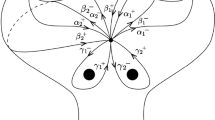Abstract:
We define a new theory of discrete Riemann surfaces and present its basic results. The key idea is to consider not only a cellular decomposition of a surface, but the union with its dual. Discrete holomorphy is defined by a straightforward discretisation of the Cauchy–Riemann equation. A lot of classical results in Riemann theory have a discrete counterpart, Hodge star, harmonicity, Hodge theorem, Weyl's lemma, Cauchy integral formula, existence of holomorphic forms with prescribed holonomies. Giving a geometrical meaning to the construction on a Riemann surface, we define a notion of criticality on which we prove a continuous limit theorem. We investigate its connection with criticality in the Ising model. We set up a Dirac equation on a discrete universal spin structure and we prove that the existence of a Dirac spinor is equivalent to criticality.
Similar content being viewed by others
Author information
Authors and Affiliations
Additional information
Received: 23 May 2000/ Accepted: 21 November 2000
Rights and permissions
About this article
Cite this article
Mercat, C. Discrete Riemann Surfaces and the Ising Model. Commun. Math. Phys. 218, 177–216 (2001). https://doi.org/10.1007/s002200000348
Issue Date:
DOI: https://doi.org/10.1007/s002200000348




